In this exercise learners will use Ansible to drive automated provisioning of Projects in OpenShift, Git, Jenkins and Nexus.
In this exercise we will use automation tooling to create Project namespaces for our CI/CD tooling along with the dev and test namespaces for our deployments to live. We do this manually using the OpenShift CLI; but as we go from cluster to cluster or project to project Dev and Ops teams often find themselves having to redo these tasks again and again. Configuring our cluster using code; we can easily store this in Git and repeat the process again and again. By minimising the time taken to do these repetitive tasks we can accelerate our ability to deliver value to our customers; working on the hard problems they face.
This exercise uses Ansible to drive the creation of the cluster content. In particular; we'll use a play book called the OpenShift Applier. Once the project namespace have been created; we will add some tools to support CI/CD such as Jenkins, Git and Nexus. These tools will be needed by later lessons to automate the build and deploy of our apps. Again; we will use OpenShift Templates and drive their creation in the cluster using Ansible. To prove things are working, finally we'll delete all our content and re-apply the inventory to re-create our cluster's content.
As a learner you will be able to
npm and Docker registries.The Big Picture is our emerging architecture; starting with an empty cluster we populate it with projects and some ci/cd tooling.
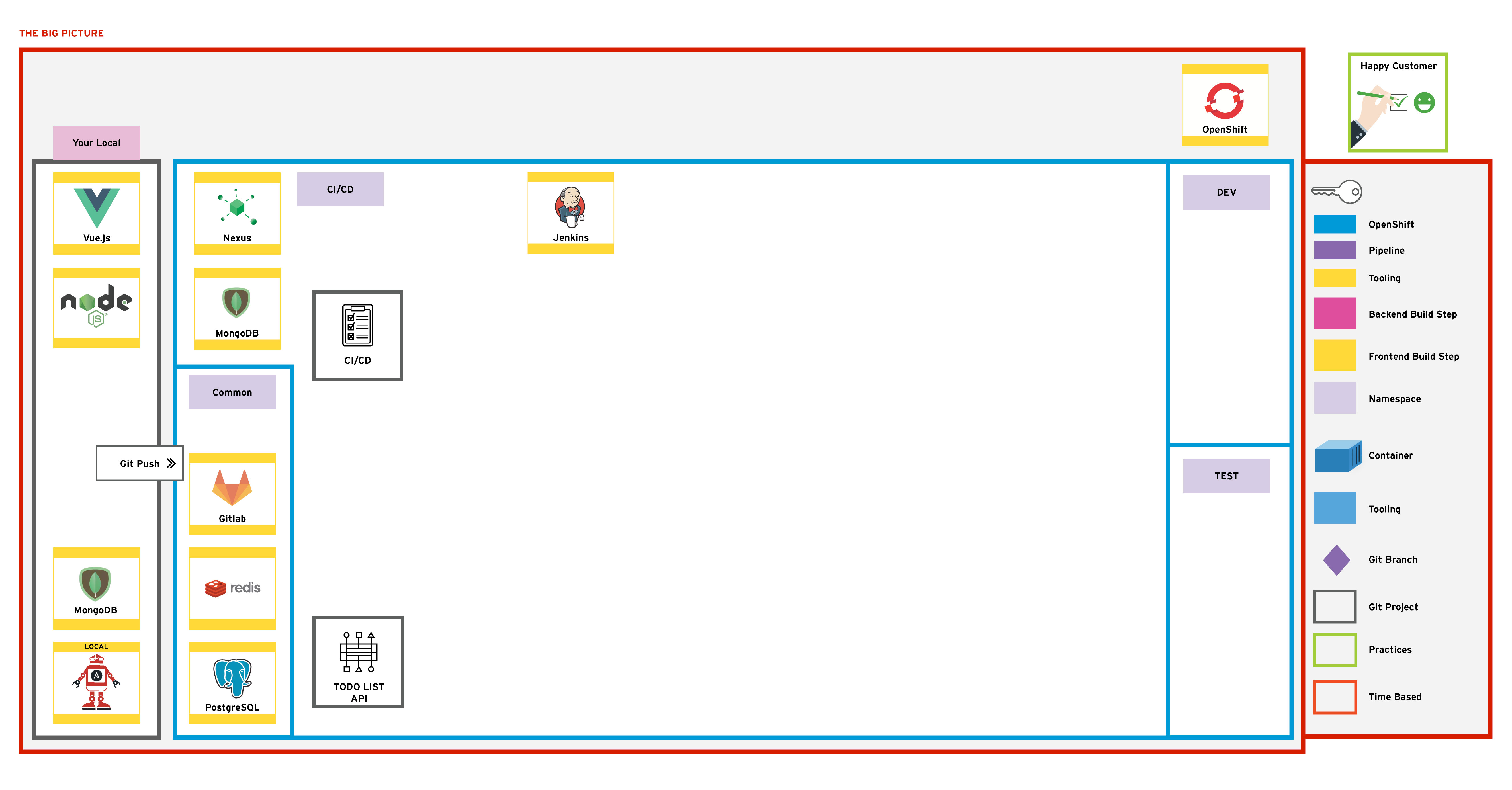
_____
Using the OpenShift Applier, we will add new project namespaces to the cluster which will be used throughout the exercise.
For Linux and MacOS systemsbash mkdir -p ~/do500-workspace && cd ~/do500-workspace
For Microsoft Windows systems, navigate to the C:\do500-workspace directorybash cd C:\do500-workspace
NOTE - If you do not want to have this folder at the root of your home directory, that's fine, just ensure any parent directories of this do500-workspace folder do NOT have any spaces in them as it breaks Ansible in later labs...
do500-workspace folder and pull all remote branches for use in later exercises. You may see an error saying fatal: A branch named 'develop' already exists. This error can be safely ignored.git clone https://github.com/RedHatTraining/rht-labs-ci-cd enablement-ci-cd
cd enablement-ci-cd
./git-pull-all.sh
If you are using a Microsoft Windows system, run the above shell script using the Git Bash terminal instead of the default Windows command line. You need to navigate to the C:\do500-workspace\enablement-ci-cd directory by runningbash cd /c/do500-workspace/enablement-ci-cd bash ./git-pull-all.sh bash exit
enablement-ci-cd folder in VSCode (or your favourite editor). The project is laid out as follows . ├── README.md ├── apply.yml ├── docker ├── inventory │ ├── host_vars │ │ ├── ci-cd-tooling.yml │ │ └── projects-and-policies.yml │ └── hosts ├── jenkins-s2i ├── params │ └── project-requests-ci-cd ├── requirements.yml └── templates └── project-requests.yml docker folder contains sample Dockerfiles for our jenkins-slave images that will be used by the builds.jenkins-s2i contains the configuration and plugins we want to bring jenkins to life withparams houses the variables we will load the templates withtemplates is a collection of OpenShift templatesinventory/host_vars/*.yml is the collection of objects we want to insert into the cluster.requirements.yml is a manifest which contains the ansible modules needed to run the playbookapply.yml is a playbook that sets up some variables and runs the OpenShift Applier role.Open the apply.yml file in the root of the project. Update the namespace variables by replacing the <YOUR_NAME> with your name or initials. Don't use uppercase or special characters. For example; my name is Dónal so I've created:yaml hosts: "{{ target }}" vars: ci_cd_namespace: donal-ci-cd dev_namespace: donal-dev test_namespace: donal-test tasks:
NOTE - YAML is indentation sensitive so keep things lined up properly!
Open the inventory/host_vars/projects-and-policies.yml file; you should see some variables setup already to create the <YOUR_NAME>-ci-cd namespace. This object is passed to the OpenShift Applier to call the templates/project-requests.yml template with the params/project-requests-ci-cd parameters. We will add some additional content here but first let's explore the parameters and the template
Open the params/project-requests-ci-cd and replace the <YOUR_NAME> with your name to create the corresponding projects in the cluster.
Let's add two more params files to pass to our template to be able to create a dev and test project.
params/project-requests-dev & params/project-requests-test. On the terminal runbash touch params/project-requests-dev params/project-requests-test params/project-requests-dev and add the following by substituting <YOUR_NAME> accordingly NAMESPACE=<YOUR_NAME>-dev NAMESPACE_DISPLAY_NAME=<YOUR-NAME> Dev params/project-requests-test and add the following by substituting <YOUR_NAME> accordingly NAMESPACE=<YOUR_NAME>-test NAMESPACE_DISPLAY_NAME=<YOUR-NAME> Test inventory/host_vars/projects-and-policies.yml file; add the new objects for the projects you want to create (dev & test) by adding another object to the content array for each. You can copy and paste them from the ci-cd example and update them accordingly. If you do this; remember to change the params file! e.g.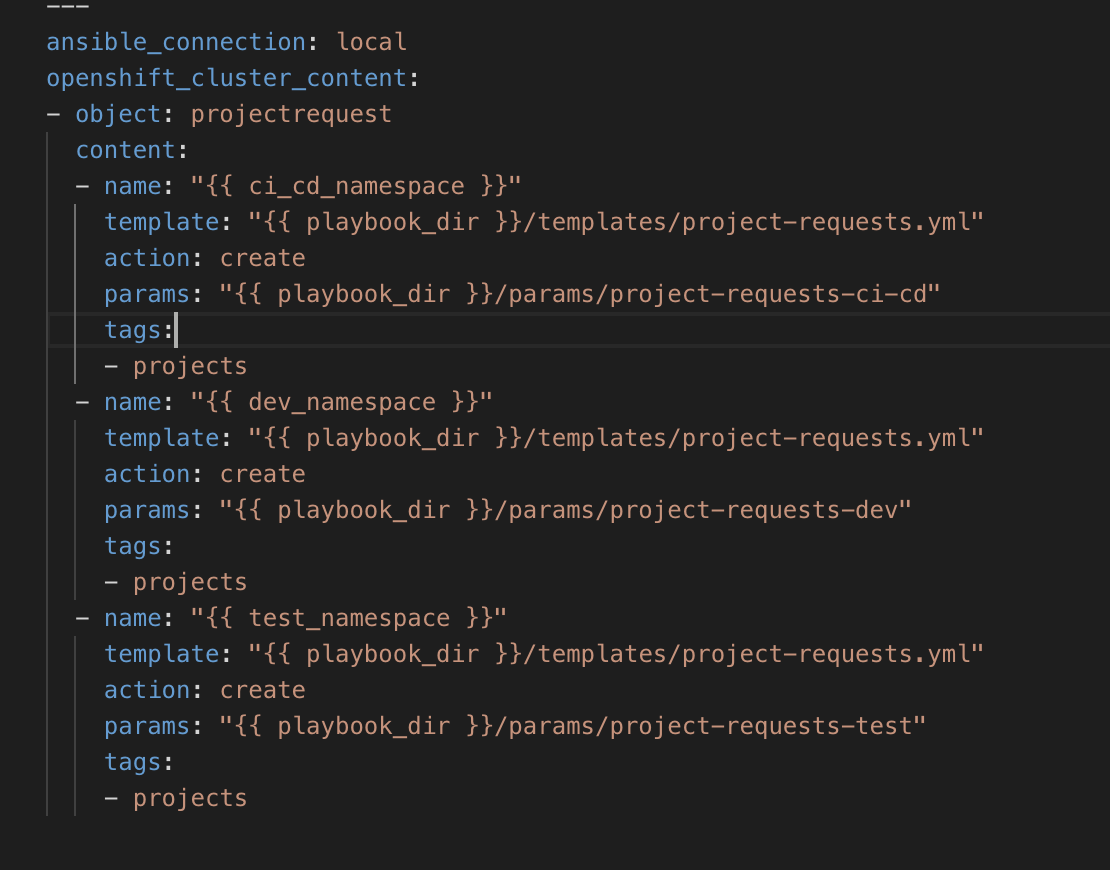
For Microsoft Windows systems, you need to run Ansible and OpenShift client commands from inside the do500-toolbox container. Linux and MacOS users should skip this step and jump directly to Step 10.
NOTE - On Microsoft Windows systems, we recommend you keep the container running for the duration of the lab. Run all Ansible and OpenShift client ("oc") CLI commands from inside the container. Do NOT launch the container on Linux and MacOS systems, since you should already have Ansible and the OpenShift client natively installed on your system by following the pre-requisites setup guide.
Launch the toolbox container using the Windows command line terminal, and navigate to the enablement-ci-cd directory inside the containerbash docker run -it -v C:/do500-workspace:/home/tool-box/workarea:Z quay.io/redhat/do500-toolbox /bin/bash bash-4.4$ cd workarea/enablement-ci-cd
With the configuration in place; install the OpenShift Applier dependencybash ansible-galaxy install -r requirements.yml --roles-path=roles
Apply the inventory by logging into OpenShift on the terminal and running the playbook as follows ( should be replaced with the one you've been provided by the instructor). Accept any insecure connection warning 👍:bash oc login <CLUSTER_URL> bash ansible-playbook apply.yml -i inventory/ -e target=bootstrap
where the -e target=bootstrap is passing an additional variable specifying that we run the bootstrap inventory
Once successful you should see an output similar to this (Cows not included): 
You can check to see the projects have been created successfully by runningbash oc projects 
Now that we have our Projects setup; we can start to populate them with Apps to be used in our dev lifecycle
In the enablement-ci-cd repo, checkout the templates for Nexus by runningbash git checkout exercise1/git-nexus templates/nexus.yml
The template contains all the things needed to setup a persistent nexus server, exposing a service and route while also creating the persistent volume needed. Have a read through the template; at the bottom you'll see a collection of parameters we will pass to the template.
Add some parameters for running the template by creating a new file in the params directory.bash touch params/nexus
The essential params to include in this file are:bash VOLUME_CAPACITY=5Gi MEMORY_LIMIT=1Gi
Create a new object in the inventory variables inventory/host_vars/ci-cd-tooling.yml called ci-cd-tooling and populate its content is as follows
---
ansible_connection: local
openshift_cluster_content:
- object: ci-cd-tooling
content:
- name: "nexus"
namespace: "{{ ci_cd_namespace }}"
template: "{{ playbook_dir }}/templates/nexus.yml"
params: "{{ playbook_dir }}/params/nexus"
tags:
- nexus
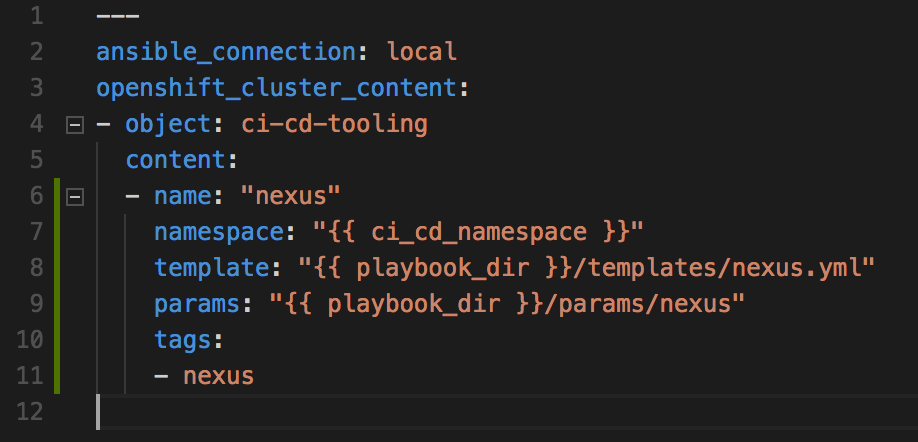
Run the OpenShift applier, specifying the tag nexus to speed up its execution (-e target=tools is to run the other inventory).bash ansible-playbook apply.yml -e target=tools \ -i inventory/ \ -e "filter_tags=nexus"
Once successful; login to the cluster through the browser (using cluster URL) and navigate to the <YOUR_NAME>-ci-cd. You should see Nexus up and running. You can login with default credentials (admin / admin123) 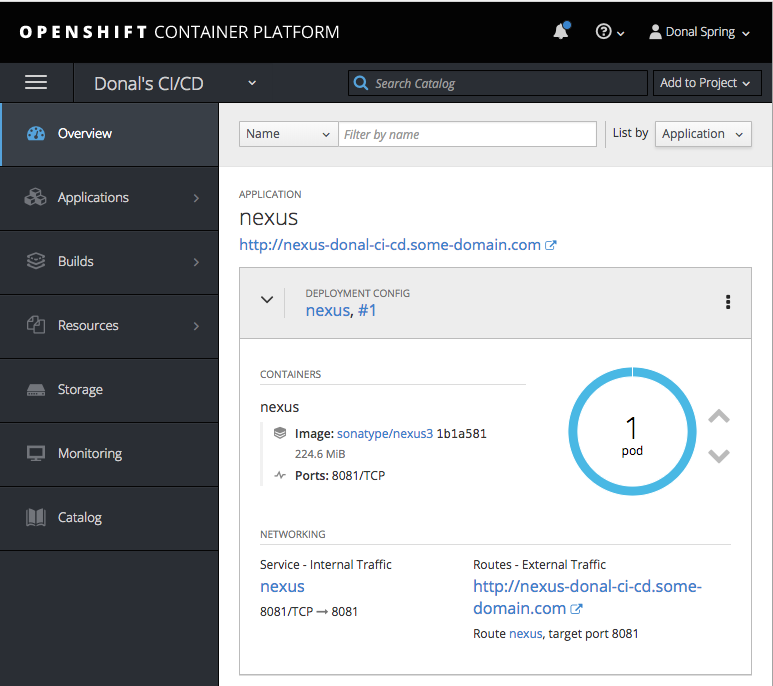
NOTE - A Gitlab instance in the cloud has already been set up for you, please check with your instructor for the Gitlab instance URL.
Navigate to GitLab login page. You can login using your cluster credentials using the LDAP tab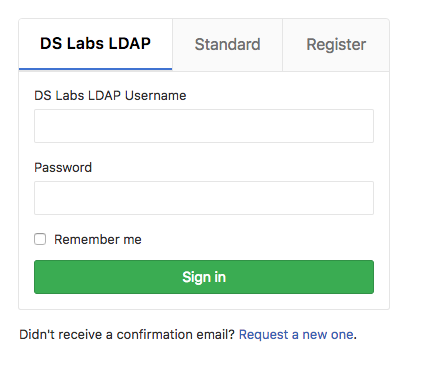
Once logged in create a new project called enablement-ci-cd and mark it as internal. Once created; copy out the git url for use on the next step.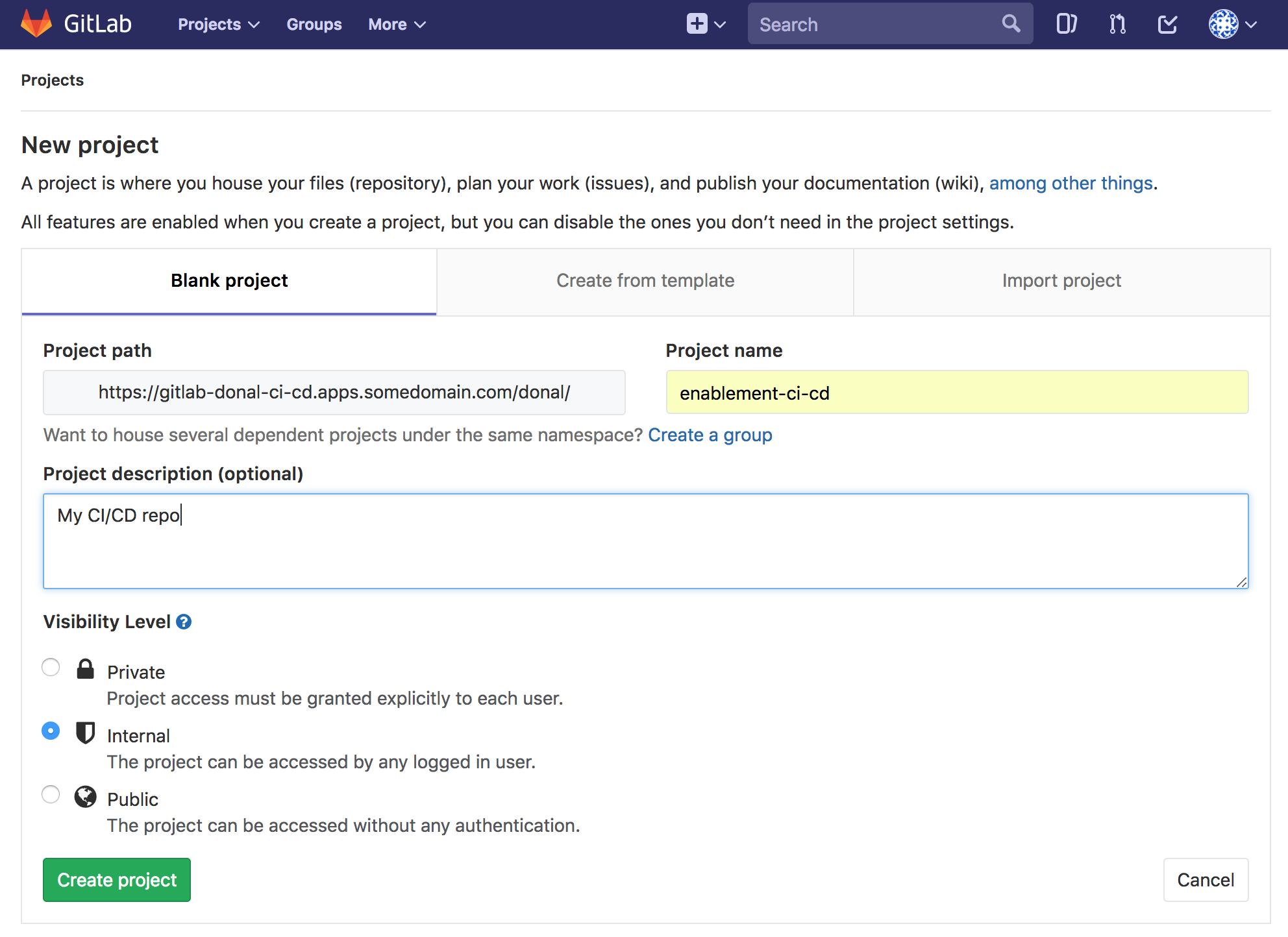
If you have not used Git before; you may need to tell Git who you are and what your email is before we commit. Run the following commands, substituting your email and "Your Name". If you've done this before move on to the next step. The last git config command is used to bypass SSL key verification in this repo since we are using self-signed certificates on the GitLab sever.
git config --global user.email "yourname@mail.com"
git config --global user.name "Your Name"
git config http.sslVerify false
<GIT_URL> accordingly with the one created for your enablement-ci-cd repository a moment ago.bash git remote set-url origin <GIT_URL> bash git add . bash git commit -m "Adding git and nexus config" bash git push -u origin --all In order to run our API tests in CI in later labs; we need a MongoDB server instance available for executing our tests. As this is part of our CI/CD Lifecycle; we will add it now.
In our enablement-ci-cd repo; checkout the mongo templates as shown below to bring in the template and params.bash git checkout exercise1/mongodb params/mongodb templates/mongodb.yml
Open enablement-ci-cd in your favourite editor. Edit the inventory/host_vars/ci-cd-tooling.yml to include a new object for our mongodb as shown below. This item can be added below the Jenkins slave in the ci-cd-tooling section.
```yaml
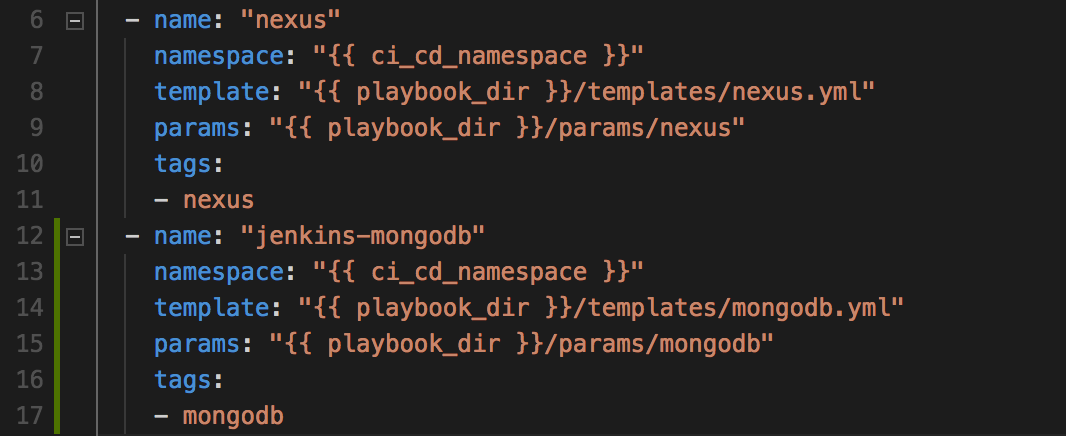
Git commit your updates to the inventory to git for traceability.bash git add . bash git commit -m "ADD - mongodb for use in the pipeline" bash git push
Apply this change as done previously using Ansible. The deployment can be validated by going to your <YOUR_NAME>-ci-cd namespace and checking if it is there!bash ansible-playbook apply.yml -e target=tools \ -i inventory/ \ -e "filter_tags=mongodb" 
Note - When making changes to the "enablement-ci-cd" repo, you should frequently commit the changes to git.
_Create a build and deployment config for Jenkins. Add new configuration and plugins to the OpenShift default Jenkins image using s2i
Add the Jenkins Build & Deployment configs to the enablement-ci-cd repo by merging the contents from the exercise1/jenkins branchbash git checkout exercise1/jenkins templates/jenkins.yml
As before; create a new set of params by creating a params/jenkins file and adding some overrides to the template and updating the <YOUR_NAME> value accordingly. MEMORY_LIMIT=3Gi VOLUME_CAPACITY=10Gi JVM_ARCH=x86_64 NAMESPACE=<YOUR_NAME>-ci-cd JENKINS_OPTS=--sessionTimeout=720
Add a jenkins variable to the Ansible inventory underneath the jenkins-mongo (and git if you have it) in inventory/host_vars/ci-cd-tooling.yml.
```yaml
This configuration, if applied now, will create the deployment configuration needed for Jenkins but the${NAMESPACE}:${JENKINS_IMAGE_STREAM_TAG}` in the template won't exist yet.To create this image we will take the supported OpenShift Jenkins Image and bake into it some extra configuration using an s2i builder image. More information on Jenkins s2i is found on the openshift/jenkins GitHub page. To create an s2i configuration for Jenkins, check out the pre-canned configuration source in the enablement-ci-cd repobash git checkout exercise1/jenkins-s2i jenkins-s2i
The structure of the Jenkins s2i config is jenkins-s2i ├── README.md ├── configuration │ ├── build-failure-analyzer.xml │ ├── init.groovy │ ├── jenkins.plugins.slack.SlackNotifier.xml │ ├── scriptApproval.xml │ └── jobs │ └── seed-multibranch-job │ └── config.xml └── plugins.txt
plugins.txt is a list of pluginId:version for Jenkins to pre-install when starting./configuration contains content that is placed in ${JENKINS_HOME}. A config.xml could be placed in here to control the bulk of Jenkins configuration../configuration/jobs/* contains job names and xml config that jenkins loads when starting. The seed job in there we will return to in later lessons.build-failure-analyzer.xml is config for the plugin to read the logs and look for key items based on a Regex. More on this in later lessons.init.groovy contains a collection of settings jenkins configures itself with when launchingSUCCESS status of Jenkins from Blue to Green. Append the jenkins-s2i/plugins.txt file withtxt greenballs:1.15 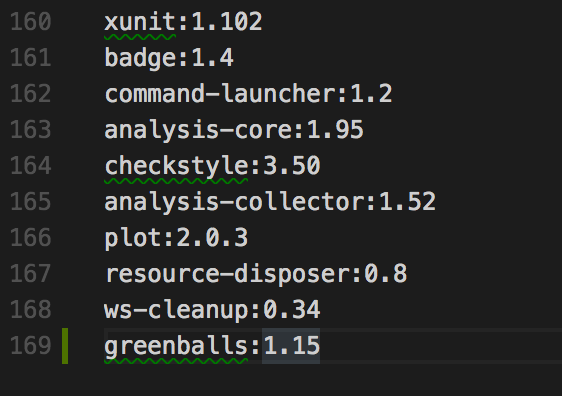
There are a few ways we can do this; either adding them to the template/jenkins.yml as environment variables and then including them in the params/jenkins file. We could also create a token in GitLab and use it as the source secret in the Jenkins template.
For the sake of simplicity, just replace the <USERNAME> && <PASSWORD> in the jenkins-s2i/configuration/init.groovy with your LDAP credentials as seen below. This init file gets run when Jenkins launches, and will setup the credentials for use in our Jobs in the next exercisesgroovy gitUsername = System.getenv("GIT_USERNAME") ?: "<USERNAME>" gitPassword = System.getenv("GIT_PASSWORD") ?: "<PASSWORD>"
Checkout the params and the templates for the jenkins-s2ibash git checkout exercise1/jenkins-s2i params/jenkins-s2i templates/jenkins-s2i.yml
Open params/jenkins-s2i and add the following content; replacing variables as appropriate. SOURCE_REPOSITORY_URL=<GIT_URL> NAME=jenkins SOURCE_REPOSITORY_CONTEXT_DIR=jenkins-s2i IMAGE_STREAM_NAMESPACE=<YOUR_NAME>-ci-cd SOURCE_REPOSITORY_USERNAME=<YOUR_LDAP_USERNAME> SOURCE_REPOSITORY_PASSWORD=<YOUR_LDAP_PASSWORD>
where
<GIT_URL> is the full clone path of the repo where this project is stored (including the https && .git)<YOUR_NAME> is the prefix for your -ci-cd project.templates/jenkins-s2i.yml<YOUR_LDAP_USERNAME> is the username builder pod will use to login and clone the repo with<YOUR_LDAP_PASSWORD> is the password the builder pod will use to authenticate and clone the repo usingCreate a new object ci-cd-builds in the Ansible inventory/host_vars/ci-cd-tooling.yml to drive the s2i build configuration.
```yaml
Commit your code to your GitLab instancebash git add . bash git commit -m "Adding Jenkins and Jenkins s2i" bash git push
In order for Jenkins to be able to run npm builds and installs we must configure a jenkins-build-slave for Jenkins to use. This slave will be dynamically provisioned when we run a build. It needs to have NodeJS and npm installed in it. These slaves can take a time to build themselves so to speed up we have placed the slave within OpenShift and you can use the following commands to be able to use them in your project.bash oc project <YOUR_NAME>-ci-cd bash oc tag openshift/jenkins-slave-npm:latest jenkins-slave-npm:latest bash oc label is jenkins-slave-npm role=jenkins-slave
This is pulling the container image into your namespace and then adding a label which will allow Jenkins to take notice of it. Don't worry if the label is already there and this last command fails!
Now your code is commited, and you have bought in the Jenkins slave; run the OpenShift Applier to add the config to the clusterbash ansible-playbook apply.yml -e target=tools \ -i inventory/ \ -e "filter_tags=jenkins"
This will trigger a build of the s2i and when it's complete it will add an imagestream of <YOUR_NAME>-ci-cd/jenkins:latest to the project. The Deployment config should kick in and deploy the image once it arrives. You can follow the build of the s2i by going to the OpenShift console's project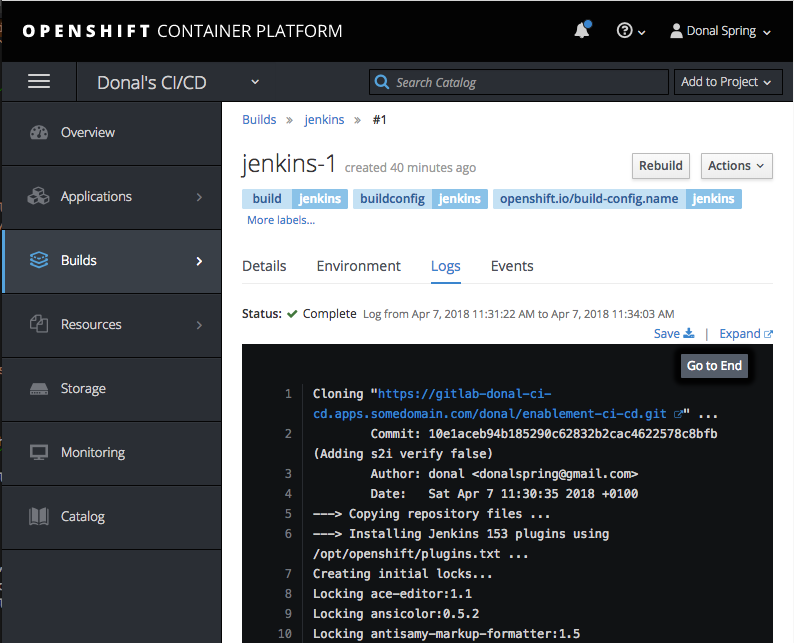
When the Jenkins deployment has completed; login (using your OpenShift credentials) and accept the role permissions. You should now see a fairly empty Jenkins with just the seed job
To test things are working end-to-end; create a hello world job that doesn't do much but proves we can pull code from git and that our builds are green.
Log in to Jenkins and hit New Item  .
.
Create a freestyle job called hello-world 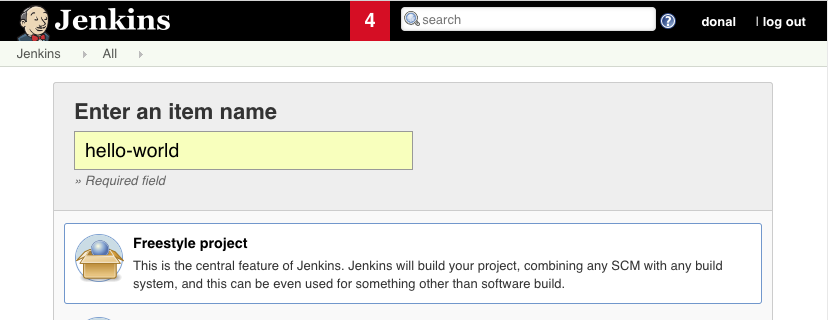 .
.
On the Source Code Management tab; add your enablement-ci-cd git repo and hit the dropdown to add your credentials we baked into the s2i on previous steps 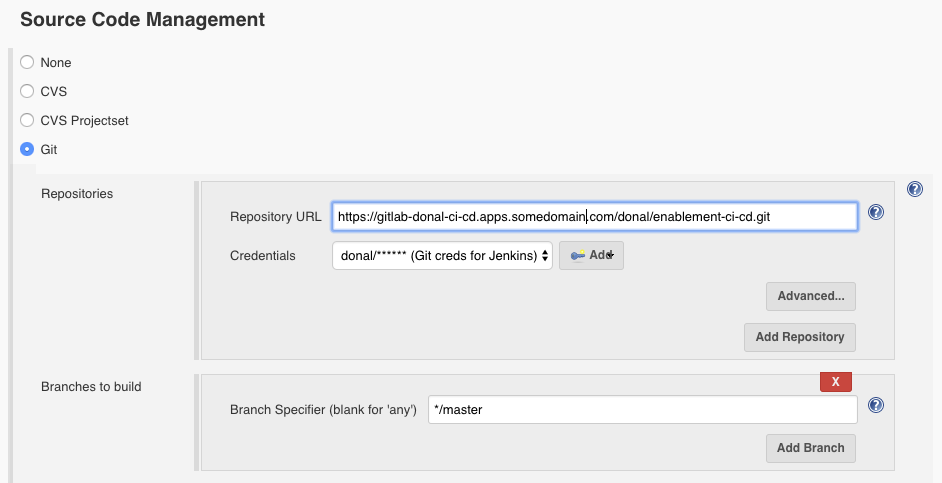
On the build tab add an Execute Shell step and fill it with echo "Hello World" 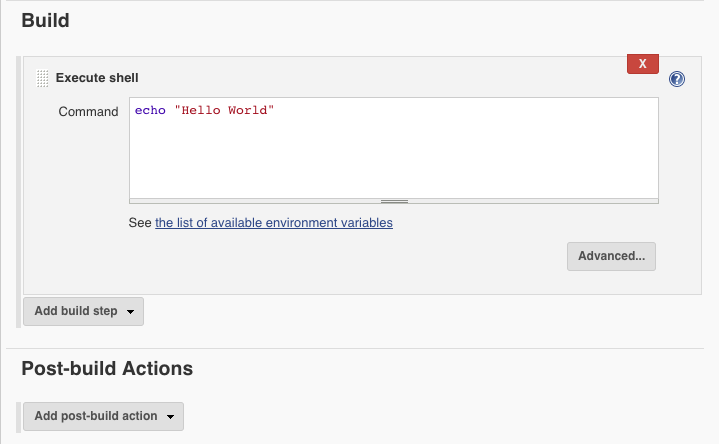 .
.
Run the build and we should see it pass successfully and with a Green ball! 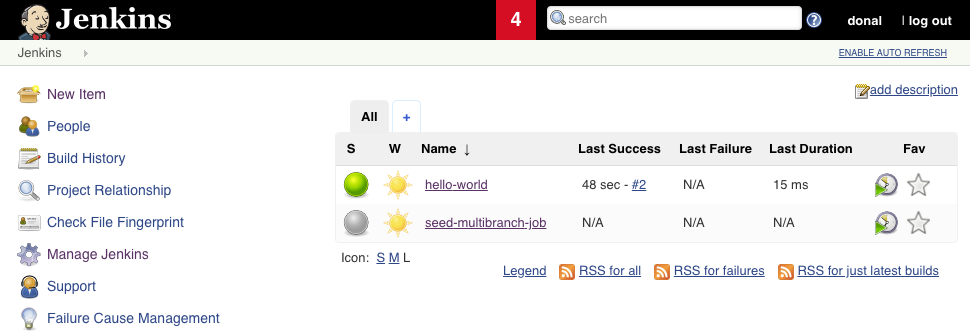
In this section you will prove the infra as code is working by deleting your Cluster Content and recreating it all
Commit your code to the new repo in GitLabbash git add . bash git commit -m "ADD - all ci/cd contents" bash git push
Burn your OpenShift project resources to the groundbash oc delete project <YOUR_NAME>-ci-cd bash oc delete project <YOUR_NAME>-dev bash oc delete project <YOUR_NAME>-test
Check to see the projects that were marked for deletion are removed.bash oc get projects | egrep '<YOUR_NAME>-ci-cd|<YOUR_NAME>-dev|<YOUR_NAME>-test'
Re-apply the inventory to re-create it all!bash oc login <CLUSTER_URL> bash ansible-playbook apply.yml -i inventory/ -e target=bootstrap bash ansible-playbook apply.yml -i inventory/ -e target=tools